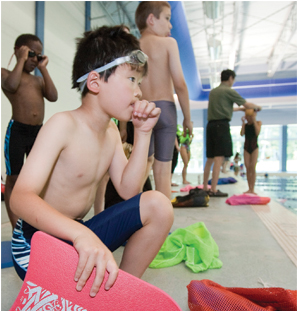As the carefree days of summer near, we are thinking about fitting into our swimsuits and getting a great tan. But if you are a lifeguard or swim instructor, you are training to prevent drowning and pool accidents across the hundreds of pools in the Triangle.
Triangle Aquatic Center trains more than 200 lifeguards who are working at most Triangle community pools this summer. More than 390,000 swimmers visit TAC per year. Lifeguards must undergo 36 hours of intensive classroom training, water drills, swim tests, CPR, automated external defibrillator operation and first-aid training. They have a huge responsibility and take their role very seriously.
Lifeguards, as diligent as they may be, do not relieve parents of their responsibilities. With hundreds of kids in the water, diving off the boards and playing on the pool deck, lifeguards cannot give children the individual attention required for their total safety. Parents are the first line of defense against accidents.
Drowning can happen to a 2-year-old in 2 inches of water in just two minutes, and it is the second leading cause of death among children. Parents play the greatest role in their children’s safety. They can begin by enrolling their kids in swim lessons. While you might think your child swims like a fish, how will they handle a severe cramp or engulfing water? Swim lessons may save their lives. They learn their physical limits, what to do if they become exhausted in the deep end and how to keep their heads above water long enough to call for help.
They work on swim strokes that make them more efficient and powerful in the water. And they build a respectful and trusting relationship with the pool staff. Lessons are available for all ages, including very young children to be taken with their parents, through older adults. Plus swim lessons are available year-round.
Enforcing the pool rules is another key role parents play in their child’s safety. Kids are kids, and they will likely forget simple rules when they dash to the diving board or cannonball their friends. How many times have you heard the guards yell out “WALK!” or “NO RUNNING!” as a child dashes across the very hard, slippery concrete deck? The next sounds you hear could be a crack and a cry. Help your children understand that the rules apply to them, too, no excuses. Lifeguards are not baby sitters and are only enforcing the rules when the parents are not being attentive. Keep the rules simple and clear for the kids. A few gentle reminders of the consequences for continually breaking the rules will go a long way for a safe summer.
The last role for parents is to stay vigilant and not be lulled by the sweet summer breeze and warm sun. While it is true that accidents are rare, the consequence can be devastating. It is also true that accidents are preventable. Have your kids take a swim test so they know their limitations. Take a water safety class so they know how to handle themselves in an emergency.
A few well-placed precautions will assure your family years of great memories.
Ways parents can protect their children around water:
– Believe that all water is potentially hazardous for children.
– Never let your child out of sight when around water, even for a quick second.
– An adult should be on the lookout, not another child.
– Teach your child to not swim alone or in an unguarded body of water.
– Dispose of standing water around the house.
– Be aware of water hazards around your neighborhood and other surroundings.
– Teach your child to swim.
– Learn CPR.
– Do not rely on flotation devices to keep your child safe.
– Learn, teach and follow the rules regarding pool deck safety.
The facts about drowning:
-It takes less than two minutes for a child to drown.
-Drowning is the second leading cause of death of children younger than 12, after car accidents.
-More than 1 in 4 drowning victims were younger than 14.
– For every child lost to drowning, another four required emergency room treatment for near or nonfatal drowning accidents.
-Nonfatal drowning can result in permanent brain damage or loss of mental functioning.
-30 percent of deaths for children 4 and younger are caused by drowning.
-Most drowning victims ages 4 and younger are left unsupervised for less than 5 minutes.
-Boys are twice as likely to drown as girls.
-There is an 89 percent increase in drowning deaths during the summer months.
Source: Centers for Disease Control
Contributed By Alisa Wright Colopy, Fit & Able Productions Inc.
Alisa Wright Colopy is the founder of Fit & Able Productions Inc. For more information, call her at (919) 673-4685 or visit www.fitandable.net.






